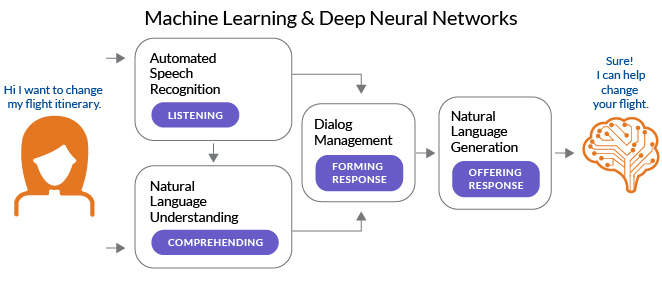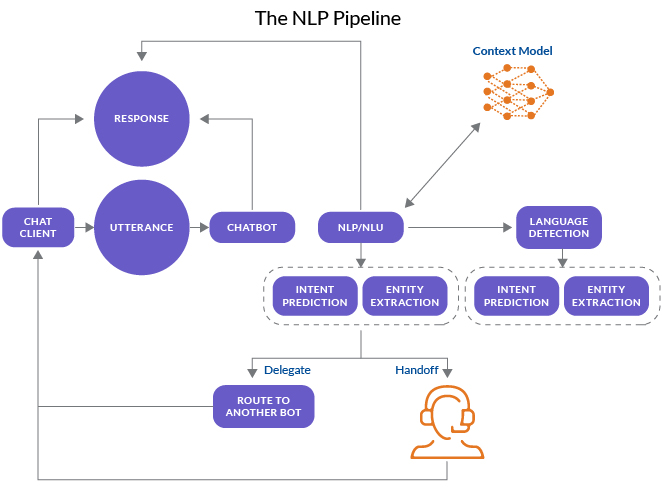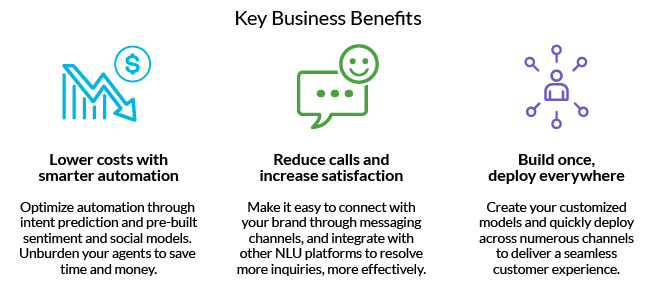Conversational AI is an umbrella term used to describe various methods of enabling computers to carry on a conversation with a human. This technology ranges from fairly simple natural language processing (NLP) to more sophisticated machine learning (ML) models that can interpret a much wider range of inputs and carry on more complex conversations.
One of the most common applications of conversational AI is in chatbots, which use NLP to interpret user inputs and carry on a conversation. Other applications include virtual assistants, customer service chatbots, and voice assistants.
Savvy consumers expect to communicate via mobile app, web, interactive voice response (IVR), chat, or messaging channels. They look for a consistent and enjoyable experience that’s fast, easy, and personalized.
For businesses, the key to meeting and exceeding these expectations across channels and at scale is intelligent automation. Conversational artificial intelligence (AI) powers interactions that are near human, improving CX, boosting satisfaction, driving loyalty, and increasing customer lifetime value (LTV).
Conversational AI can be broken down into five core components. These five core components work together to enable a computer to understand and respond to human conversation:
1. Natural language processing
NLP is the ability of a computer to understand human language and respond in a way that is natural for humans. This involves understanding the meaning of words and the structure of sentences, as well as being able to handle idiomatic expressions and slang.
NLP is made possible by machine learning, which is used to train computers to understand language. NLP algorithms use large data sets to learn how words are related to each other, and how they are used in different contexts.
2. Machine learning
Machine learning is a field of artificial intelligence that enables computers to learn from data without being explicitly programmed. Machine learning algorithms can automatically improve their performance as they are exposed to more data.
Machine learning is used to train computers to understand language, as well as to recognize patterns in data. It is also used to create models of how different things work, including the human brain.
3. Text analysis
Text analysis is the process of extracting information from text data. This involves identifying the different parts of a sentence, such as the subject, verb, and object. It also includes identifying the different types of words in a sentence, such as nouns, verbs, and adjectives.
Text analysis is used to understand the meaning of a sentence, as well as the relationships between different words. It is also used to identify the topic of a text, as well as the sentiment (positive or negative) of the text.
4. Computer vision
Computer vision is the ability of a computer to interpret and understand digital images. This involves identifying the different objects in an image, as well as the location and orientation of those objects.
Computer vision is used to identify the contents of an image, as well as the relationships between different objects in the image. It is also used to interpret the emotions of people in photos, and to understand the context of a photo.
5. Speech recognition
Speech recognition is the ability of a computer to understand human speech. This involves recognizing the different sounds in a spoken sentence, as well as the grammar and syntax of the sentence.
Speech recognition is used to convert spoken words into text, and to understand the meaning of the words. It is also used to interpret the emotions of people speaking in a video, and to understand the context of a conversation.
Driven by underlying machine learning and deep neural networks (DNN), a typical conversational AI flow includes:
In many cases, the user interface, NLP, and AI model are all provided by the same provider, often a conversational AI platform provider. However, it's is also possible to use different providers for each of these components.

There is no one-size-fits-all answer to this question, as the best way to create conversational AI depends on the specific needs and use cases of your organization. However, some tips on how to create conversational AI include:
1. Start by understanding your use cases and requirements.
The first step in creating conversational AI is understanding your organization’s specific needs and use cases. What are you trying to achieve with your chatbot? What type of conversations do you want it to be able to have? What data do you need to collect and track? Defining these requirements will help you determine the best approach to creating your chatbot.
2. Choose the right platform and toolkit.
There are a number of different platforms and toolkits that you can use to create conversational AI. Each platform has its own strengths and weaknesses, so you need to choose the platform that best suits your needs. Some popular platforms include [24]7.ai Conversations, Microsoft Bot Framework, Amazon Lex, Google Dialogflow, and IBM Watson.
3. Build a prototype.
Once you have defined your requirements and chosen a platform, it’s time to start building your prototype. Building a prototype will help you test your chatbot and iron out any kinks before deploying it to your users.
4. Deploy and test your chatbot.
Once your prototype is finished, it’s time to deploy and test your chatbot. Make sure to test it with a small group of users first to get feedback and make any necessary adjustments.
5. Optimize and improve your chatbot.
The final step is to continually optimize and improve your chatbot. You can do this by tweaking the algorithms, adding new features, and collecting user feedback.

There are a number of ways to implement conversational AI. The most common way is to use natural language processing (NLP) to convert text into machine-readable data. This data can then be used to power a chatbot or other conversational AI system.
NLP, as noted earlier, is a process of understanding human language and using that understanding to convert text into a format that a computer can understand. This process can be used to interpret questions and commands from users, as well as to analyze and respond to user feedback.
There are a number of different approaches to NLP. Some systems use machine learning to train a computer to understand natural language. Others use a rules-based approach, where a human editor creates a set of rules that define how the computer should interpret and respond to user input.
Once the computer has been trained or has been given a set of rules, it can then use this information to power a chatbot or other conversational AI system. This system can be used to handle customer support inquiries, answer questions, and carry out other tasks that would traditionally require human interaction.
Many tools are now available for building chatbots and speech bots that deliver automated conversation development, however, conversation design is not straightforward and remains a human-led discipline.
In customer service, the ability to resolve requests at a high rate and satisfaction level is critical. Successful resolution depends on intent determination and intent handling. To understand intent better, machine learning (ML) models are trained on actual conversations. That conversational data is tagged by human analysts and contact center agents, and augmented with signals including behavioral (for example, prior web pages viewed), enterprise (order status), and external (local weather/events). This makes for smarter intent prediction and faster resolution.
Unsupervised ML techniques are also used to mine customer-agent conversations to determine common dialogue flow patterns. The sample set of conversational data used for model training is chosen from top-notch agents, as determined by resolution rates and customer satisfaction ratings. Identified flows then give conversation designers a much better starting point for writing dialogues.
Conversations often contain more than one intent. To fully automate an interaction, conversation designers must incorporate intent sequences into their bot design. If the bot is unable to handle the second and subsequent intents, the customer will have to escalate to a human agent—which increases the cost of the interaction. And if a human agent isn’t available, the customer is left with a partially complete interaction—which is probably worse than no interaction at all.
Conversational AI technologies depend on an intent-driven conversation design to deliver solutions for specific use cases such as customer support, IT service desk, marketing, and sales support. Conversational AI also offers integration with chat interfaces in SMS, web-based chat, and other messaging platforms.
Explore how to design conversational AI chatbots and remember, thoughtful conversation design is a key component for success and the ability to turn visitors into engaged customers.
When we speak about automated human-computer digital interactions, the line between chatbots and conversational AIcan start to blur. Oftentimes, the terminologies have been used interchangeably. So, is conversational AI different from a chatbot? To begin with, let’s look at how they’re connected at a fundamental level:
Conversational AI brings together a range of advanced capabilities for an omnichannel UI, contextual awareness, language processing, response generation, intent management, exception/escalation management, advanced analytics, and integration.
A chatbot, on the other hand, is a computer application that simulates human conversation through voice commands, text input, or both. Chatbots make it easy for users to find the information they need in real time, automate responses to user queries, and can complete tasks without the need for human intervention.
Chatbots support a range of digital (for example, messaging apps, mobile apps, website) and voice channels (IVR, smart speakers) to offer both customers and employees a conversational, self-serve experience at scale.
The name chatbot, short for chatterbot, is also often used interchangeably with bot, virtual assistant, AI chatbot, conversational agent, and talkbot.
Want to deep dive into the different type of chatbots? Start here: All About AI-Powered Chatbots.
Conversational AI contains components that allow it to capture user inputs; break down, process, and understand them; and generate a meaningful response in a natural way—all within microseconds. This is possible because conversational AI combines NLP with machine learning (ML) to continuously improve the AI algorithms.
For convenience, let’s bundle scripted and rule-based chatbots together and call them “traditional chatbots”. So, there are traditional chatbots and AI-powered chatbots. Here’s a side-by-side comparison of the two:
Traditional chatbots |
AI-powered chatbots |
|
|
|
|
|
For more on this topic, check out the blog: Conversational AI and Chatbots: How We Got Here.
Conversational AI’s maturity has steadily increased over the past few years to the point where it can now deliver excellent business value and outcomes for companies. Nevertheless, challenges abound since this is also a fast-evolving conversational commerce category where very few vendors are constantly innovating and bringing new technologies to the market. Challenges include:
Technology behind conversational bot experiences is based on the latest advances in artificial intelligence, NLP, sentiment analysis, deep learning, and intent prediction. Together, these features encourage engagement, improve customer experience and agent satisfaction, accelerate time to resolution, and grow business value.
Most conversational AI uses NLU to intelligently process user inputs against multiple models, enabling a bot to respond in a more human-like way to non-transactional journeys. The core technology understands slang, local nuances, colloquial speech, and can be trained to emulate different tones by using AI-powered speech synthesis.
This leading conversational AI technology layer abstracts pre-built sentiment and social models to prioritize and seamlessly escalate to an agent when it detects that a customer needs expert advice. Sentiment detection will recognize, for example, an upset customer and immediately route them to an agent. You can also prioritize unhappy customers in the system, placing them in special queues or offering exceptional services.
This machine learning technique is inspired by the human brain or ‘neural network’ and allows AI to learn by association, just like a child. The more data AI is exposed to, the better it gets—and the more accurately it can respond over time. AI models trained with many years of contact center data from various voice and digital channels result in smarter and more accurate responses to human inquiries. Response accuracy can be further improved over time by learning from interactions between customers, chatbots, and human agents, and optimizing intent models using AI-powered speech synthesis.
Using behavioral analysis and tagging activities, conversational AI technologies can understand the true meaning behind each consumer’s request. Knowing intent allows companies to deliver the right response at the right moment through an automated bot or human agent.
The future roadmap for conversational AI platforms includes support for multiple use cases, multi-domain, and multiple vertical needs, along with explainable AI.
According to Gartner™, over 1500 conversational AI providers now offer various levels of capability, language support, use-cases, and business models. Sophistication swings widely depending on what’s supported, such as:
Horizontal solutions are the most flexible and controllable but take longer to implement, while vertical specific ones come with pre-built capabilities that are a better fit for a specialized use cases in a target domain. Vendors that offer vertical solutions built on an established horizontal platform give companies full flexibility in customizing to meet their precise needs.
According to Gartner, the conversational AI platform market is predicted to grow 75% year-over-year from about $2.5 billion in 2020. Platform vendors now provide differentiated value to businesses with advanced functionality that supports automated intent and entity detection, smaller training datasets, human-in-the loop tools for annotation and conversation design, and a low-code/no-code paradigm for non-technical people to build smart chatbots and virtual assistants.
When it comes to selecting a conversational AI solution, there are a few key factors to consider.
Once you have a better understanding of your business needs and the capabilities of different conversational AI solutions, you can begin to narrow down your options and select the right platform for your business.
[24]7 AIVA™ Conversational AI is a technology layer that combines the world’s most advanced NLP technology with an intent-driven engagement platform to enable ‘near-human’ conversations in digital and voice channels. AIVA understands slang, local nuances, and colloquial speech, and can be trained to emulate different tones by using AI-powered speech synthesis.

To find out how [24]7.ai’s leading conversational AI technology can change the game for your automated customer conversations, contact us today.

By 2017 AI was everywhere, it seemed like every company added “AI” to their software whether it truly leveraged arti

Every transaction starts with a conversation—and today, those conversations take place through technology.

Customer expectations are higher than ever, and meeting or exceeding them requires more than even the best agent or

An AI virtual assistant is an application program that understands natural language voice commands and completes tas